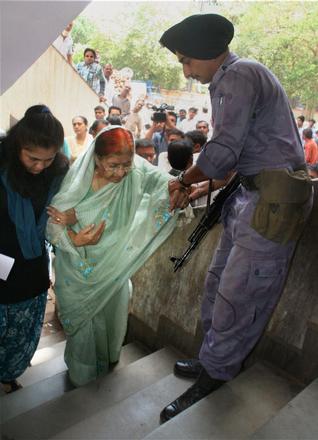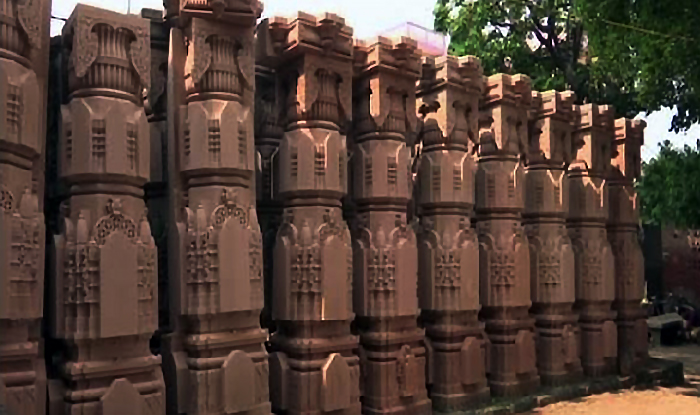 New Delhi, May 11: In its closure report filed in the Zakia Jafri case, the R.K. Raghavan-led Special Investigation Team says Ms. Jafri's husband and former MP Ehsan Jafri was killed because he provoked a “violent mob” that had assembled “to take revenge of Godhra incident from the Muslims.” Ehsan Jafri fired at the mob and “the provoked mob stormed the society and set it on fire.” Around 70 Muslims perished in the massacre at the Gulberg Society compound along with the ex-MP on February 28, 2002.
New Delhi, May 11: In its closure report filed in the Zakia Jafri case, the R.K. Raghavan-led Special Investigation Team says Ms. Jafri's husband and former MP Ehsan Jafri was killed because he provoked a “violent mob” that had assembled “to take revenge of Godhra incident from the Muslims.” Ehsan Jafri fired at the mob and “the provoked mob stormed the society and set it on fire.” Around 70 Muslims perished in the massacre at the Gulberg Society compound along with the ex-MP on February 28, 2002.
Ironically, the SIT makes this assertion even as it clears Narendra Modi of the charge that he had invoked the Newtonian theory of ‘action and reaction' to justify the post-Godhra anti-Muslim violence. Yet, in trying to absolve Mr. Modi, the SIT fully implicates the Chief Minister and itself. Not once but twice.
The SIT first insists that Mr. Modi saw the firing by Ehsan Jafri as “action” and the “massacre that followed as ‘reaction'.” It follows this up by quoting the Chief Minister as saying the Sabarmati carnage was a “heinous crime, for which ‘reactions' were being felt.”
In 1984, Rajiv Gandhi gave a macabre twist to the anti-Sikh pogrom that followed Indira Gandhi's assassination, saying “when a big tree falls, the ground shakes.” Eighteen years later, the Gujarat Chief Minister would propound his own action-reaction theory only to furiously deny he ever said it. Now the SIT not only confirms that Mr. Modi used the words “action” and “reaction” but endorses his statements even while holding that the “alleged statements” have been “quoted out of context … and therefore no case is made against him.”
The SIT's controversial observations are recorded in a chapter dealing with a specific allegation made by Ms. Jafri: that Mr. Modi had given media statements, including an interview to Zee TV on March 1, 2002, where he justified the anti-Muslim pogrom as a reaction to the Godhra violence by Muslims. Strongly defending the Chief Minister against the charge, the SIT cites its own March 2010 interrogation of Mr. Modi: “As regards the Zee TV interview of 01-03-2002 is concerned, Shri Modi told SIT that after a period of eight years, he did not recollect the exact words but he had always appealed only and only for peace … He also said that if his words cited in this question are considered in the correct perspective, then it would be evident that there is a very earnest appeal for people refraining from any kind of violence …”
The Zee TV interview was reproduced in a report, Rights and Wrongs, brought out in the aftermath of the 2002 violence by an Editors Guild team of B.G. Verghese, Aakar Patel and Dileep Padgaonkar. In the reproduced excerpts, Mr. Modi had termed the firing by Ehsan Jafri as “action” and the massacre as “reaction.” He also described the Godhra carnage as a product of the “criminal tendencies” of the residents of Godhra. He said, “Earlier, these people killed female teachers. And now they have committed a heinous crime jiski pratikria ho rahi hai (reaction to the crime is happening now).
The SIT summoned Zee TV correspondent Sudhir Chaudhary, and asked him for a CD of the interview. Mr. Chaudhary said he did not have the CD with him but recollected that to his question on the Gulberg massacre, Mr. Modi had replied that “the mob had reacted on account of private firing done by late Ahesan Jafri.”
In the closure report, the SIT summarises the episode, and goes on to offer its own conclusions: “In this connection, it is to be stated that Shri Narendra Modi has clearly stated in his Zee TV interview that it was late Ahesan Jafri, ex-MP, who first fired at violent mob and the provoked mob stormed the society and set it on fire. In this interview, he has clearly referred to Jafri’s firing as ‘action’ and the massacre that followed as ‘reaction’. It may be clarified here that in case late Ahesan Jafri, ex-MP, fired at the mob, this could be an immediate provocation to the mob, which had assembled there to take revenge of Godhra incident from the Muslims.”
The SIT also justifies Mr. Modi’s description of Godhra residents as people with “criminal tendencies” and his statement that the heinous crime (burning of Sabarmati train) had led to reactions. “Again with regard to the Godhra incident, [Mr. Modi] clearly stated that the day before yesterday 40 ladies and children were burnt alive at Godhra and the incident had shocked the nation as well as people abroad, and that the people belonging to this area had a criminal tendency and these people had earlier killed lady teachers and now they had committed heinous crime for which the reactions were being felt.”
That said, the SIT concludes that “no case is made [out] against the Chief Minister.”
So what caused Jafri to fire at the mob which was so “provoked” by the action that it “stormed inside” and killed nearly 70 Muslim residents of Gulberg society? In 2004, then Police Commissioner P.C. Pande deposed on this before the G.T. Nanavati- K.G. Shah Commission.
According to him, he got a message at about 12.15 p.m. on February 28, 2002 from the Meghaninagar police station (where Gulberg is located) that “a crowd of nearly 10,000 had gathered near Gulberg Society and that society is encircled and the crowd pelting stones.” Mr. Pande said in the deposition that he could not recollect if he got distress calls from Gulberg but he sent “two Additional Deputy Superintendents of Police with the Police Force.” He did not send further assistance because he felt that “generally PI (police inspector) and DCP (Deputy Commissioner of Police) are capable to control such situation.”
Mr. Pande claimed that following a fresh request at 2 p.m., he sent one section of the Central Industrial Security Force. However, Mr. Pande said he was unaware of the whereabouts of the men he had sent as reinforcement: “I cannot say where they were and what duties they were performing at the time when the persons of Gulberg Society were started to be burnt.” The Police Commissioner was also unaware of an affidavit filed by the Police Inspector attached to Meghaninagar where he (the PI) had said that between 2.30 and 3 p.m. there were only 14 policemen near Gulberg society. This was the situation at Gulberg at about 3 p.m., with the Police Commissioner not knowing where his men were and a Police Inspector complaining that there were only 14 policemen. By 5 p.m. the mob had killed Ehsan Jafri and many others.
Curiously, in a background note to Zakia Jafri’s complaint, the SIT says Ehsan Jafri fired in “self-defence” — in contrast to how it portrays the same incident later in the report, when it invokes the action–reaction words of Mr. Modi.
This is what the SIT’s background note says about the Gulberg incident: “On the day of the bandh, i.e. 28.02.2002, a huge mob comprising about 20,000 Hindus gathered, armed with deadly arm weapons, in furtherance of their common intention and indulged in attack on the properties, shops and houses of Muslims as well as a madrasa/mosque of Gulberg society located in Meghaninagar, Ahmedabad city, resulting in the death of 39 Muslims, including Ahesan Jafri, ex-MP, injuries to 15 Muslims and 31 Muslims went missing. Late Ahesan Jafri fired from his private, licensed weapon in self defence causing injuries to 15 persons in the mob. One of the victims of the said private firing succumbed to injuries later.”
Within the space of a few pages, however, what the SIT saw as “self-defence” in one context had become a “provocation.”
Ehsan Jafri’s widow went to the Supreme Court to ask for an investigation into the wider circumstances in which her husband lost his life. The SIT’s conclusion seems to be that his murder was his own fault.






Comments
Add new comment